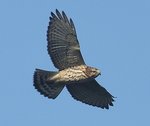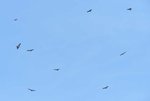 Narrowsburg
NarrowsburgLight Rain Fog/Mist, 43°
Wind: 8.1 mph
 Narrowsburg
NarrowsburgIf you have been in or near the woods during this past summer, you may have heard a high-pitched single-note whistle. It is piercing and carries a fairly long distance, even through the forest. …
Stay informed about your community and support local independent journalism.
Subscribe to The River Reporter today. click here
This item is available in full to subscribers.
Please log in to continue |


If you have been in or near the woods during this past summer, you may have heard a high-pitched single-note whistle. It is piercing and carries a fairly long distance, even through the forest. Occasionally, you may have spotted a stubby-winged hawk, appearing somewhat like a miniature red-tailed hawk, sounding this call. If you were close enough, or had binoculars, you would have noticed a barred tail. This raptor is one of the many bird species that breed in the region, but do not stay here. This is the broad-winged hawk, and now is the time they leave to migrate south.
During the summer, broad-winged hawks spend a lot of time under forest canopies, and therefore are heard more than seen. Around the beginning of September, the first few broad-winged hawks can be seen riding the lift being generated near mountain ridges as they head south. Unlike species of migrating raptors that spread their migration over the course of the fall, broad-winged hawks tend to migrate en masse in large flocks. The largest number of these hawks are counted around September 20 at hawk-counting sites in the region.
At the peak of the broad-winged hawk migration, it is not uncommon to count several hundred or even thousands of these migrants in the course of a day. They tend to pick a path in the sky as they stream southward; they will glide in a line and several abreast, making that portion of the sky resemble a busy freeway. When a good thermal is found, they will all circle in the same direction in a huge “kettle.” Trying to count hawks in a large kettle can be a challenge.
Soaring along the ridges catching orographic [relating to mountains] lift and taking advantage of upwelling thermals saves a lot of energy for these migrating broad-wing hawks; they need to fly as efficiently as they can. Several years ago, four broad-winged hawks were captured and equipped with satellite transmitters. These telemetered birds flew an average of 69 miles per day and an average total distance of 4,350 miles to their wintering grounds in northern South America.
Although the broad-winged migration will be past its peak by the time you read this, there will still plenty of broad-wing hawks migrating through the region into October (and by October, other species will be making their migration flight). The best place to see the migration in the area is Sunrise Mountain in Stokes State Forest in Sussex County, NJ. Visit hawk count.org to find this site and others in the area.
Comments
No comments on this item Please log in to comment by clicking here